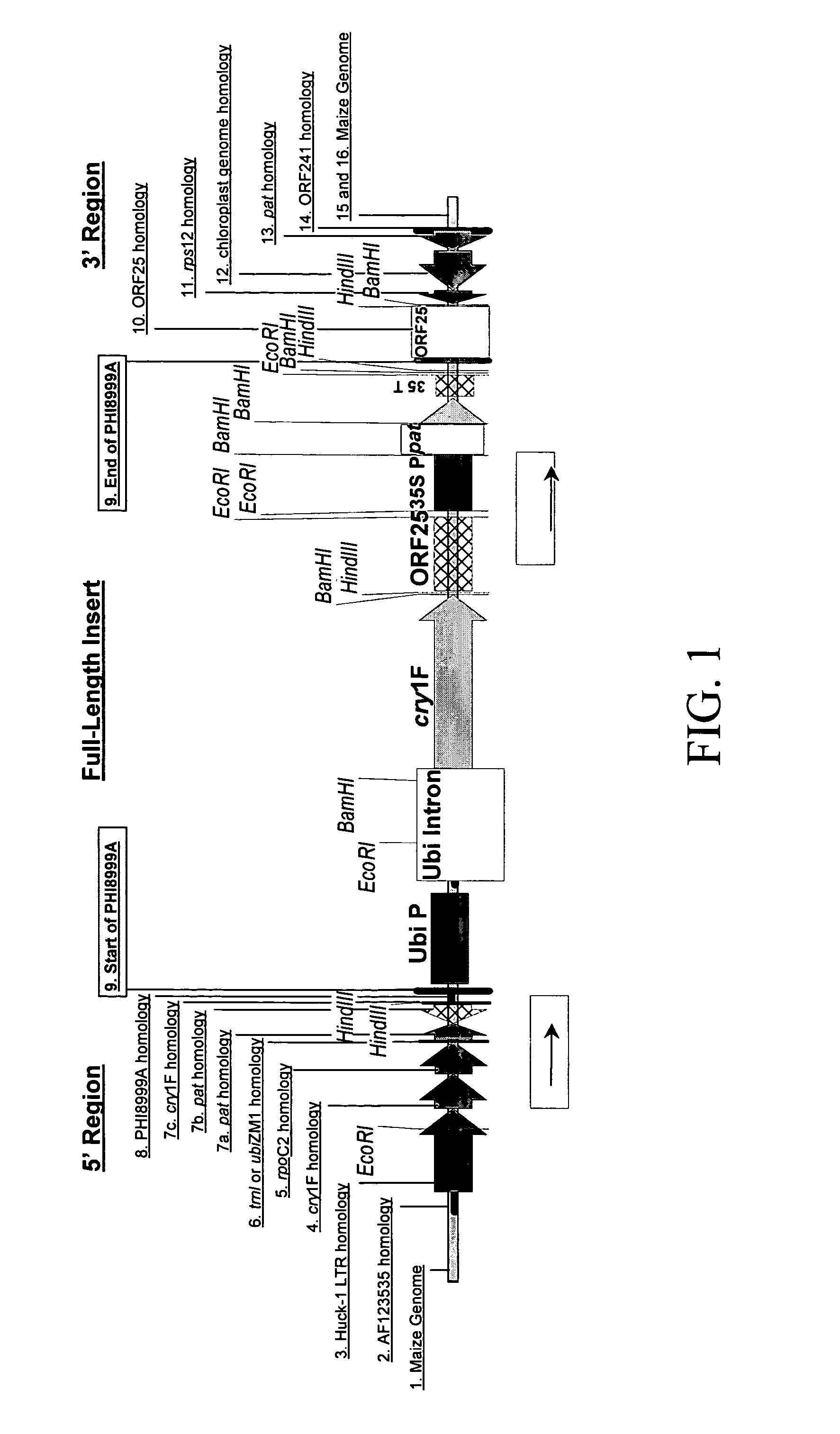Corn event TC1507 and methods for detection thereof
a technology of corn event and detection method, which is applied in the field of plant molecular biology, can solve the problems of inconvenient detection methods, damage caused by insect pests, and the loss of corn crops in the world,
- Summary
- Abstract
- Description
- Claims
- Application Information
AI Technical Summary
Benefits of technology
Problems solved by technology
Method used
Image
Examples
example 1
Transformation of Maize by Particle Bombardment and Regeneration of Transgenic Plants Containing the Cry1F Gene
[0084]A DNA molecule of 6.2 Kb, designated PHI8999A (see FIG. 1 and SEQ ID NO:25), which includes a first transgene expression cassette comprising the promoter, 5′ untranslated exon, and first intron of the maize ubiquitin (Ubi-1) gene (Christensen et al. (1992) Plant Mol. Biol. 18:675-689 and Christensen and Quail (1996) Transgenic Res. 5:213-218) operably connected to a DNA molecule encoding a Bacillus thuringiensis δ-endotoxin identified as Cry1F (U.S. Pat. Nos. 5,188,960 and 6,218,188) operably connected to a DNA molecule comprising a 3′ ORF25 transcriptional terminator isolated from Agrobacterium tumefaciens (Barker et al. (1983) Plant Mol. Biol. 2:335-350), and a second transgene expression cassette comprising a DNA molecule of the cauliflower mosaic virus (CaMV)35 S promoter (Odell J. T. et al. (1985) Nature 313: 810-812; Mitsuhara et al. (1996) Plant Cell Physiol. 3...
example 2
Identification of Nucleotides Comprising the Flanking Sequence 5′ to the Transgenic Insert DNA in Bacillus thuringiensis Cry1F Maize Line TC1507
[0087]To identify a DNA fragment that included sequence 5′ to the PHI8999A insert in event TC1507, Spe I restriction enzyme fragments from event TC1507 genomic DNA were size selected on agarose gels, purified, and screened by Southern analysis to confirm hybridization to a Cry1F probe. Following confirmation of hybridization and fragment size, the fragments of interest were cloned into a pBluescript II SK (+)™ cloning vector to prepare an enriched size selected plasmid based genomic DNA library. A probe homologous to a portion of the Cry1F gene was used to screen the plasmid library for positive clones. A positive clone was identified, purified by additional screening, and confirmed to result in a positive signal when hybridized to the Cry1F probe. Nearly 3 Kb of the Spe I fragment contained in the isolated positive clone was sequenced using...
example 3
Confirmation of Flanking Sequence 5′ to the B.t. Cry1F Maize Line TC1507 Insert
[0088]To confirm the 5′ flanking sequence of the B.t. Cry1F maize line TC1507 insert, PCR primer pairs were designed to obtain overlapping PCR products extending from the 5′ flanking region into the full-length PHI8999A transgenic insert. PCR products were successfully amplified from B.t. Cry1F maize line TC1507 genomic DNA, isolated, and sequenced for Region 1 through Region 6, shown in Table 1, and confirmed to match the previously determined sequence from the Spe I fragment, described in Example 2. However, the region from bp 2358 to bp 2829, immediately adjacent and 5′ to the start of the full-length insert was recalcitrant to PCR amplification and appeared to be larger than the sequence obtained from the Spe I clone described above. The use of primer pairs flanking this region and the Advantage®—GC 2 Polymerase Mix (BD Biosciences Clontech, Palo Alto, Calif.) was successful in amplifying PCR products...
PUM
| Property | Measurement | Unit |
|---|---|---|
| Tm | aaaaa | aaaaa |
| Tm | aaaaa | aaaaa |
| Tm | aaaaa | aaaaa |
Abstract
Description
Claims
Application Information
 Login to View More
Login to View More - R&D
- Intellectual Property
- Life Sciences
- Materials
- Tech Scout
- Unparalleled Data Quality
- Higher Quality Content
- 60% Fewer Hallucinations
Browse by: Latest US Patents, China's latest patents, Technical Efficacy Thesaurus, Application Domain, Technology Topic, Popular Technical Reports.
© 2025 PatSnap. All rights reserved.Legal|Privacy policy|Modern Slavery Act Transparency Statement|Sitemap|About US| Contact US: help@patsnap.com

